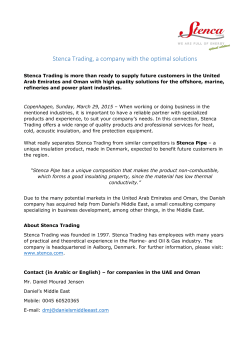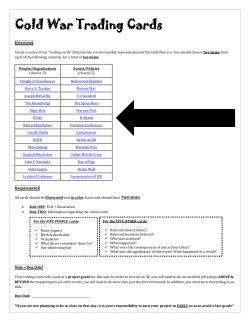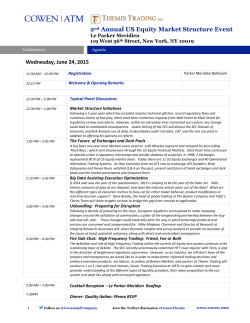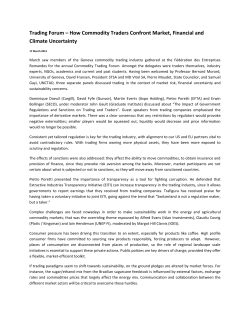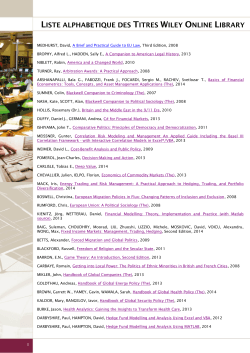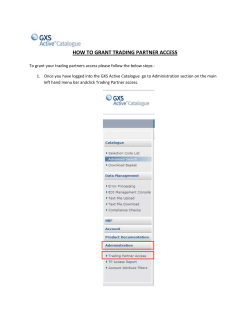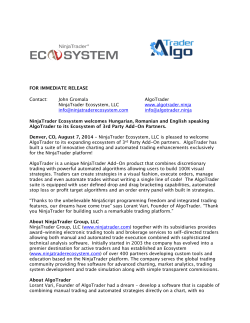
Market Microstructure in Practice: Why and how to trade
Market Microstructure in Practice: Why and how to trade optimally in a fragmented market Charles-Albert Lehalle Senior Research Advisor, Capital Fund Management, Paris April 2015, Printed the April 13, 2015 CA Lehalle 1/7 Purpose of these Lectures It is not the presentation of a recent research, but a mix of my former experience as the Global Head of Quant Research of the Equity Brokerage and Derivative Dept. of a large Investment Bank (Crédit Agricole CIB), with a specific focus on trading since I started at CACIB as Head of Quant Research of its brokerage arm (CA Cheuvreux), my current one as Senior Research Advisor in an hedge fund (CFM), and the questions I have or had to answer to the French regulator (AMF), the European one (ESMA), and other entities I have positions into. Nevertheless I only talk on my behalf, all that is written or said is only my opinion and not theirs. My three lectures are split across: I The Emergence of Continuous Trading . In this part I will deal with microstructural topics in the classical sense, but with a specific angle: the one of the role of the financial system. We will talk about intermediation, fragmentation, regulation, market making, etc. I What to model and what for? is the question I will address during the second part. Of course it is linked with the user of the model. The role of market participants, their needs in modelling (observed market dynamics and/or the nature of their interactions with markets) will be discussed. From an empirical or a theoretical viewpoint. I Optimal trading? In what sense? During the last part I will simply focus on the principal — agent problem in optimal trading (we will have a lot of talks about optimal trading techniques this week), and open the topics to big data with the issue of monitoring hundreds of trading algorithms in realtime. CA Lehalle 2/7 More Details About the Talks The Emergence of Continuous Trading . I The role of financial markets in the financial system I Recent evolutions of microstructure I Fragmentation(s) What to model and what for? I Market participants I Observing short term dynamics: simple descriptions I Short term dynamics: towards orderbook modelling I Modelling interactions with markets: Market Impact Optimal trading? In what sense? I Optimal trading in the Principal-Agent problem I Monitoring trading algorithms: a machine learning viewpoint CA Lehalle 3/7 Main Supporting Papers and Books I Optimal Trading. 1. Bruno Bouchard, Ngoc-Minh Dang, and Charles-Albert Lehalle. Optimal control of trading algorithms: a general impulse control approach. SIAM J. Financial Mathematics, 2(1):404–438, 2011. 2. O. Guéant, Charles-Albert Lehalle, and J. Fernandez-Tapia. Optimal Portfolio Liquidation with Limit Orders. SIAM Journal on Financial Mathematics, 13(1):740–764, 2012. 3. Olivier Guéant and Charles-Albert Lehalle. General intensity shapes in optimal liquidation. Mathematical Finance, page n/a, October 2013. 4. Olivier Guéant, Charles-Albert Lehalle, and Joaquin Fernandez-Tapia. Dealing with the inventory risk: a solution to the market making problem. Mathematics and Financial Economics, 4(7):477–507, September 2013. 5. Mauricio Labadie and Charles-Albert Lehalle. Optimal starting times, stopping times and risk measures for algorithmic trading. The Journal of Investment Strategies, 3(2), March 2014. 6. Charles-Albert Lehalle. Market Microstructure knowledge needed to control an intra-day trading process. In Jean-Pierre Fouque and Joseph Langsam, editors, Handbook on Systemic Risk. Cambridge University Press, May 2013. Market Microstructure. 7. Lehalle, C.-A., Laruelle, S., Burgot, R., Pelin, S., and Lasnier, M. (2013). Market Microstructure in Practice. World Scientific publishing. CA Lehalle 4/7 Main Supporting Papers and Books II 8. Frédéric Abergel, Jean-Philippe Bouchaud, Thierry Foucault, Charles-Albert Lehalle, and Mathieu Rosenbaum, editors. Market Microstructure Confronting Many Viewpoints. Wiley, 2012. 9. Emmanuel Bacry, Adrian Iuga, Matthieu Lasnier, and Charles-Albert Lehalle. Market Impacts and the Life Cycle of Investors Orders. Social Science Research Network Working Paper Series, December 2014. 10. Paul Besson and Charles-Albert Lehalle. The Deal/Book Split Analysis: A New Method to Disentangle the Contribution to Market and Limit Orders in Any Price Change. Social Science Research Network Working Paper Series, January 2014. 11. Weibing Huang, Charles-Albert Lehalle, and Mathieu Rosenbaum. Simulating and analyzing order book data: The queue-reactive model, December 2013. 12. Aimé Lachapelle, Jean-Michel Lasry, Charles-Albert Lehalle, and Pierre-Louis Lions. Efficiency of the Price Formation Process in Presence of High Frequency Participants: a Mean Field Game analysis, May 2013. 13. Charles-Albert Lehalle, Matthieu Lasnier, Paul Besson, Hamza Harti, Weibing Huang, Nicolas Joseph, and Lionel Massoulard. What does the saw-tooth pattern on US markets on 19 July 2012 tell us about the price formation process. Technical report, Crédit Agricole Cheuvreux Quant Note, August 2012. 14. Charles-Albert Lehalle, Olivier Guéant, and Julien Razafinimanana. High Frequency Simulations of an Order Book: a Two-Scales Approach. In F. Abergel, B. K. Chakrabarti, A. Chakraborti, and M. Mitra, editors, Econophysics of Order-Driven Markets, New Economic Windows. Springer, 2010. CA Lehalle 5/7 Main Supporting Papers and Books III Stochastic Algorithms for trading. 15. Gilles Pagès, Sophie Laruelle, and Charles-Albert Lehalle. Optimal split of orders across liquidity pools: a stochastic algorithm approach. SIAM Journal on Financial Mathematics, 2:1042–1076, 2011. 16. Sophie Laruelle, Charles-Albert Lehalle, and Gilles Pagès. Optimal posting price of limit orders: learning by trading. Mathematics and Financial Economics, 7(3):359–403, June 2013. 17. Robert Azencott, Arjun Beri, Yutheeka Gadhyan, Nicolas Joseph, Charles-Albert Lehalle, and Matthew Rowley. Realtime market microstructure analysis: online Transaction Cost Analysis. Quantitative Finance, pages 0–19, March 2014. CA Lehalle 6/7 And more... CA Lehalle 7/7
© Copyright 2025
